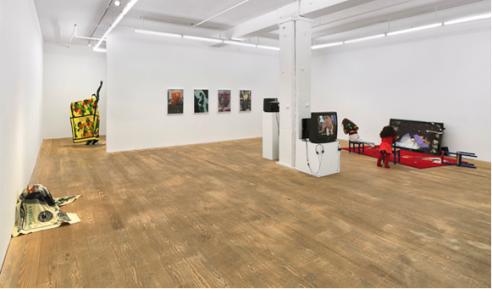
The Phantasm, 2011, installation view, Foxy Production, New York. Photo by Mark-Woods.com.
Foxy Production
The Phantasm
June 9-July 29, 2011
Foxy Production
623 W 27 St
NYC 10001 USA
T +1 212.239.2758
F +1 212.239.2759
www.foxyproduction.com
Tuesday-Friday 11am-6pm
STEPHEN ABRY, KAI ALTHOFF, JANET BURCHILL, DESTINY DEACON, VIRGINIA FRASER, ISA GENZKEN, K8 HARDY, JUDITH HOPF, HENRIK OLESEN, JENNIFER MCCAMLEY, DANNY MCDONALD, AND MICHAEL RILEY CURATED BY ROBERT MCKENZIE.
In Spring 2001 the now defunct interior design magazine Nest ran an article on a child born with the decorator gene, "The D-Gene." As the editor Joseph Holtzman describes: "Last October, rumor of an extraordinary being reached us. I do believe in the D-Gene, and here was a six-year-old decorator of unmistakable talent, maybe even genius… Neither his parents nor brother Max are fazed in the slightest to be living with a genetic decorator, if that is what little Polo-shirt-loving Dan really is." Of course the diagnosis is dubious and perhaps that is the point.
Holtzman's suggestion of a genetic predisposition for décor most obviously riffs on and satirizes the notion of the "Gay Gene," although it might just as easily undermine the categories of class, race, and gender. This speculation provokes an array of questions: In the realm of learned behaviors, what might an aptitude for aesthetic choices actually indicate? Is the procession of aesthetic choice, lauded in the pursuits of painting and sculpture, anything other than an elaborate entropy? Are the attendant cultural significations of style and decoration baseless whimsy? What of the claims of ethnology? And what traction might identity make within this commotion?
In response to these questions, I considered how phantasms-illusions or apparitions-assist or hinder the rendering of my own body. The political, social and economic possibilities invoked by phantasms seemed fundamental to my formation. These possibilities are contained within the perception, the prescriptive component of my imaginary. Phantasms, through their historical iterations, a synthesis of the social, and the concrete economy of the object, suggest behaviors to me.
The French writer and artist Pierre Klossowski has written extensively on the nature of phantasms and their implications for identity: "One believes that one chooses freely to be what one is, but one is only ever playing a role, while not being what one is; therefore one is playing a role of what one is outside of oneself. One is never where one is, but always where one is only the actor of that other which one is."
The interplay between the economy of a style and its phantasm is an infinitely reflexive one and, I make no pretense at unraveling it. The phantasm and its related notion of the simulacrum are primary in the navigation of our individual economy. For those oppressed by their situation, they allow the apparition of an alternative, the discovery of other ways of being outside themselves.
The oppression or liberation enacted by the phantasm is at the crux of my concerns. Style and decoration are far from what I had originally conceived: their collective hallucinations are free-wielding friend and foe. Their vicissitudes demand much from the individual. One must be highly attuned when committing one's self to the throes of such negotiation. The children's game of dress-ups suggests this politic, although its innocence must surely be disputed. Disposition itself is at stake here and so the phantasm must be studied with the utmost earnestness, as well as with jest. The artist is uniquely positioned to experiment in this maelstrom. This exhibition is dedicated to such research.-ROBERT McKENZIE.
Thanks to the artists; Arts Victoria; Galerie Daniel Buchholz, Berlin/Cologne; Brett Millspaw; Roslyn Oxley9 Gallery, Sydney; Scott Cameron Weaver; Gladstone Gallery, New York; The Estate of Michael Riley; Reena Spaulings Fine Art, New York; Alex Zachary, New York; and David Zwirner, New York.